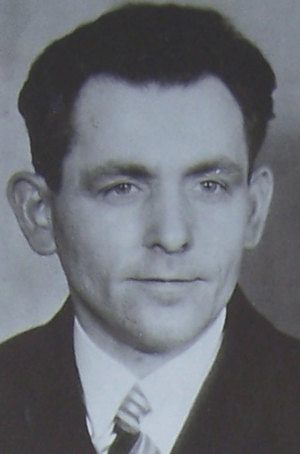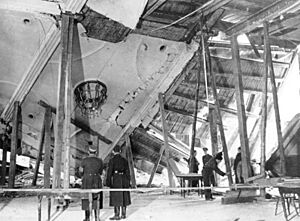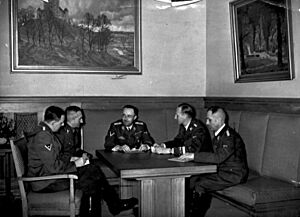Georg Elser facts for kids
Quick facts for kids
Georg Elser
|
|
|---|---|

Photo in a personnel file of Georg Elser from the Düsseldorf State Police Headquarters
|
|
| Born |
Johann Georg Elser
4 January 1903 Hermaringen, Württemberg, German Empire
|
| Died | 9 April 1945 (aged 42) Dachau concentration camp, Dachau, Nazi Germany
|
| Cause of death | Execution |
| Occupation | Carpenter |
| Known for | Attempting to assassinate Adolf Hitler |
Johann Georg Elser (German: [ˈɡeː.ɔʁk ˈɛl.zɐ]]; 4 January 1903 – 9 April 1945) was a brave German worker. He tried to assassinate Adolf Hitler and other important Nazi leaders. This happened on 8 November 1939, at a place called the Bürgerbräukeller in Munich.
Elser built a bomb and hid it near where Hitler was giving a speech. The bomb exploded, but Hitler had left earlier than planned. Sadly, the explosion killed 8 people and injured 62 others. Elser was held prisoner for over five years. He was executed at Dachau concentration camp just before Nazi Germany surrendered.
Contents
Georg Elser's Early Life
Family and Childhood
Georg Elser was born in Hermaringen, Württemberg. His parents were Ludwig Elser and Maria Müller. They got married a year after he was born. Georg often helped care for his five younger brothers and sisters. He went to elementary school in Königsbronn from 1910 to 1917. He was good at drawing, writing, and math.
His Jobs and Interests
After school, Elser worked with his father for a short time. He then started learning to be a lathe operator. Later, he became a skilled woodworker. He worked in furniture factories and even shaped wooden propellers for an aircraft company called Dornier.

Elser also worked in clock factories. He joined a group called the Red Front-Fighters League, which was linked to Communists. He also enjoyed traditional German dance groups. He played musical instruments like the flute, accordion, and zither. He joined the Zither Club in Königsbronn.
Elser met a woman named Elsa Härlen. He moved into her home and built furniture for her.
His Beliefs and Views
Elser was a carpenter and a member of a woodworkers' union. He voted for the Communist Party because he thought they best supported workers. He disliked Nazism from the start in 1933. He refused to do the Hitler salute and didn't listen to Hitler's speeches on the radio. He also didn't vote in Nazi elections.
Elser believed that Hitler and his leaders were harming Germany. He felt that removing them was the only way to make things better and prevent a war. He also became more religious in 1939, attending church and praying. He said he wanted to prevent "even greater bloodshed" with his actions.
The Plan to Stop Hitler
Why Elser Acted
Elser explained that he wanted to improve life for workers and stop a war. He believed that removing Hitler, Goering, and Goebbels would change Germany's policies. He got the idea to act in late 1938. He learned from newspapers that the Nazi leaders would meet in Munich at the Bürgerbräukeller on 8 and 9 November 1938.
Planning the Bombing
To plan his attack, Elser visited the Bürgerbräukeller in Munich on 8 November 1938. He couldn't get in until late, after the crowd left. He stayed until midnight to look around. He decided the best place for a bomb would be inside a pillar right behind the speaker's stage.
Elser worked at a factory that made weapons. He secretly stole explosives and hid them. He went back to Munich in April 1939 to get exact measurements of the pillar. He also got more explosives and detonators from a quarry where he worked. He tested his bomb ideas in an orchard. He used clock parts and a car signal light to create a timer for his bomb.
Setting the Bomb
Elser arrived in Munich on 5 August 1939. He rented a room and started visiting the Bürgerbräukeller regularly for dinner. After the hall closed around 10:30 p.m., he would stay inside.
For two months, Elser spent 30 to 35 nights inside the Bürgerbräukeller. He built a secret door in the wooden paneling of the pillar. Behind it, he carved out a space in the brickwork for his bomb. He usually finished working around 2:00 or 3:00 a.m. He would then sleep in a storeroom until the doors opened at 6:30 a.m., leaving with a suitcase full of debris.
Security at the Bürgerbräukeller was not very strict. Elser also built his bomb device during the day, buying extra parts and using a local woodworker's shop. In early November, he placed the explosives inside the pillar. On 4–5 November, he installed the special clock mechanism that would set off the detonator.
On 6 November, Elser left Munich to stay with his sister in Stuttgart. He returned to Munich the next day for a final check of the bomb. After making sure everything was set, he left Munich by train and then by steamer to Konstanz.
The Bürgerbräukeller Bombing
| Bürgerbräukeller Bombing | |
|---|---|

The Bürgerbräukeller after the bombing
|
|
| Location | Bürgerbräukeller, Munich |
| Planned by |
|
| Objective |
|
| Date | 8 November 1939, 21:20 (UTC+2) |
| Executed by | Georg Elser |
| Outcome |
|
| Casualties | 8 killed, 62 injured |
Hitler's Escape
On 8 November 1939, Adolf Hitler and other top Nazis were at the Bürgerbräukeller for their annual meeting. Hitler had originally canceled his speech but changed his mind. Because of a fog forecast, he decided to return to Berlin by train that night. This meant he had to leave Munich earlier.
So, Hitler started his speech half an hour earlier than planned and made it shorter. He finished speaking at 9:07 p.m. Elser's bomb exploded at 9:20 p.m., just 13 minutes later. By then, Hitler and his group had already left the building.
The bomb caused part of the ceiling and roof to fall. The gallery and an outside wall also collapsed. About 120 people were still in the hall. Seven people died immediately, and one more died later. Sixty-three people were injured, sixteen of them seriously.
Hitler found out about the bombing later that night. He said, "A man has to be lucky." He also believed it was a sign that "Providence" (fate) wanted him to succeed.
Honoring the Victims
On 11 November, a special ceremony was held in Munich for the victims of the bombing. Hitler returned from Berlin for the event. He stood before seven flag-draped coffins. Rudolf Hess gave a speech, saying the crime was "almost unparalleled in history." He claimed it would make the German people hate more and that the war would turn out well for Hitler and Germany.
After a sad song, Hitler placed a wreath on each coffin and gave the Nazi salute.
Elser's Capture and Imprisonment
His Arrest
On the night of 8 November, at 8:45 p.m., Elser was caught by two border guards near the Swiss border in Konstanz. When they searched him, they found wire cutters and notes with sketches of explosive devices. At 11 p.m., news of the Munich bombing arrived. The next day, Elser was taken to Gestapo Headquarters in Munich.

The Investigation
Hitler ordered Heinrich Himmler to investigate the bombing. Himmler put Heinrich Müller, the head of the Gestapo, in charge. Müller immediately arrested everyone who worked at the Bürgerbräukeller.
Investigators found parts of the bomb that led them to a clock maker in Schwenningen, Germany. Himmler, however, told the press that the parts suggested a "foreign origin." He offered a huge reward of 500,000 marks for information.
Soon, many suspects were brought in. A 16-year-old girl named Maria Schmauder told police about her family's recent boarder, Elser. She mentioned he was working on an "invention" and had a suitcase with a false bottom.
Interrogation and Confession
At Gestapo Headquarters in Munich, Elser was identified by a waitress as an unusual customer. A storekeeper also recognized him by his accent as the man who bought "sound proofing insulation" for clocks.
Police noticed Elser's knees were badly bruised, likely from working on the bomb at night. Elser was questioned very harshly. On 15 November, he made a full written confession, admitting he acted alone.
Elser was moved to Gestapo Headquarters in Berlin. His family members and former girlfriend, Elsa Härlen, were also brought to Berlin and questioned in front of him. Elsa Härlen later said Elser looked badly beaten. She felt he was only saying what his questioners wanted to hear.
To convince them he acted alone, Elser drew five detailed pictures of his bomb. The Gestapo was so impressed by his craftsmanship that they used his bomb design in their training manuals.
Nazi Propaganda
Even though Elser confessed to acting alone, Hitler used the bombing for propaganda. German newspapers claimed Elser was funded by British Intelligence. They showed photos of Elser next to two British officers who had been captured. The Nazis wanted to make it seem like other countries were behind the attack.
Life in Prison
Elser was never put on trial. After a year of intense questioning in Berlin, he was held in special custody at Sachsenhausen concentration camp from 1941 to 1945. He had his own cells and a workspace to make furniture and zithers. He even received extra food and daily shaves.
In early 1945, Elser was moved to the "bunker" (a special prison area) at Dachau concentration camp.
Elser's Death and Legacy
His Final Days
In April 1945, with Germany losing the war, the Nazis decided not to have a public trial for Elser. Hitler ordered his execution. The order, dated 5 April 1945, told the Dachau camp commander to kill Elser during an air raid on Munich or Dachau. They were to pretend he died from the attack.
On 9 April 1945, just four weeks before the end of World War II in Europe, Georg Elser was shot and killed. He was 42 years old. In 1954, an SS officer named Theodor Bongartz was identified as Elser's murderer.
A plaque in Königsbronn, where Elser grew up, says:
"I wanted to prevent even greater bloodshed through my deed".
In memory of Johann Georg Elser, who spent his youth in Königsbronn. On 8 November 1939, he tried to prevent the genocide by assassinating Adolf Hitler. On 9 April 1945, Johann Georg Elser was murdered in the Dachau concentration camp.
Conspiracy Theories and Recognition
For a long time, there were rumors and theories that Elser didn't act alone. Some thought the Nazis staged the bombing to make Hitler look lucky. However, historical research in 1969, based on the Gestapo's interrogation report, confirmed that Elser acted by himself.
Unlike other resistance fighters, Elser was not widely recognized in Germany until the 1990s. Since 2001, the Georg-Elser Prize has been given every two years for acts of courage. In 2003, a special stamp was issued for his 100th birthday.
There are now over 60 streets and places named after Elser in Germany, along with several monuments. In 2011, a 17-meter (56-foot) steel sculpture of Georg Elser was put up in Berlin. A plaque in Munich marks the spot where Elser's bomb was hidden in the Bürgerbräukeller.
Elser's story has also been told in films, including Seven Minutes (1989) and 13 Minutes (2015). He is now seen as a true German hero who stood up against injustice.
See also
 In Spanish: Georg Elser para niños
In Spanish: Georg Elser para niños
- List of assassination attempts on Adolf Hitler




